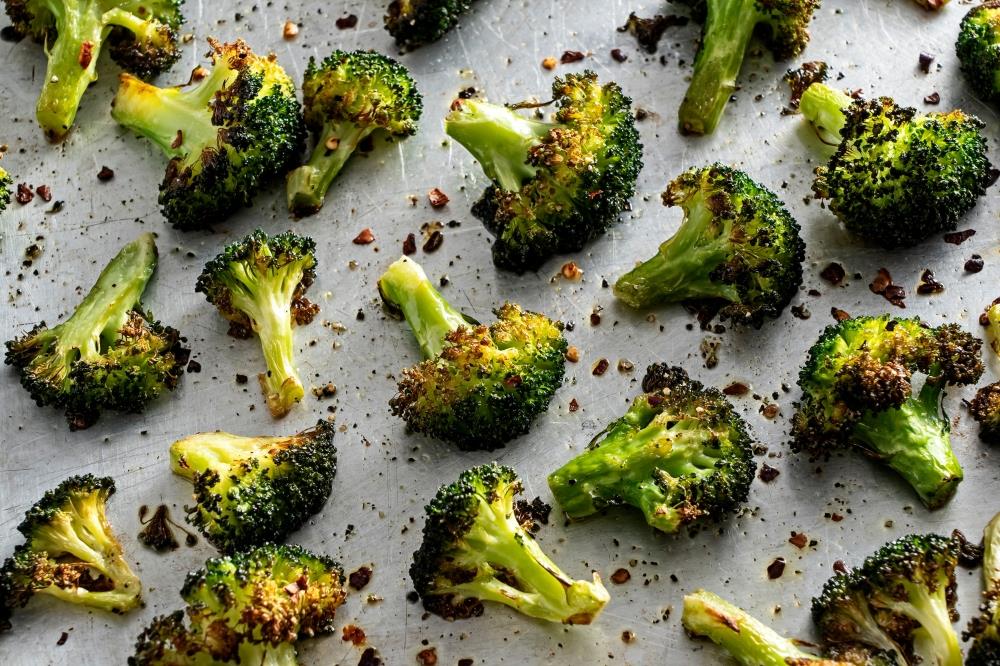
The Best Ways To Cook Broccoli, Beyond Roasting Florets
I was at a young, impressionable age when President George HW Bush made his somewhat tongue-in-cheek declaration to the press that "I do not like broccoli. And I haven't liked it since I was a little kid and my mother made me eat it. And I'm president of the United States, and I'm not going to eat any more broccoli!”
You have to wonder how many kids this inspired to push back on eating the green, cruciferous vegetable, but I wasn't one of them. I loved broccoli, at least the kind that came in my go-to Chinese restaurant order of beef and broccoli. It was, if not my introduction to broccoli, then at least my favorite way to eat it.
As I went from picky to adventurous in my eating habits, my enthusiasm for broccoli only grew. I especially embraced roasted florets with nothing other than olive oil and salt as a quick, easy and nutritious side that went with just about anything.
If that's also your preferred way to prepare broccoli, I've previously shared tips on how to achieve crispy roasted vegetables, including getting them as dry as possible before cooking, preheating the sheet pan as the oven heats up and giving your oven enough time to reach the temperatures I like for high-heat roasting, 400 to 500 degrees.
But that method is just one path to broccoli bliss. Here are other techniques and recipes to try for different textures and preparations.
- - -
Whole roasted broccoli
Picture by Tom McCorkle and food styling by Gina Nistico for The Washington Post
Roasted florets we've covered. Whole roasted cauliflower is also well-trodden territory. Whole roasted broccoli? That's not something you see as often. But you should. As Food and Dining editor Joe Yonan wrote, "The approach might remind you of a whole roasted cauliflower, but broccoli's less-dense flesh makes the path to tenderness much shorter. You don't have to cover it, boil it or steam it in advance, the way some roasted-cauliflower recipes require.”
- - -
Steamed broccoli
Picture by Laura Chase de Formigny and food styling by Lisa Cherkasky for The Washington Post
Steaming is a great way to quickly cook broccoli while retaining its texture and bright green color, not to mention nutrients. In a steamer set in a pot over a bit of simmering water, broccoli will be ready in just a few minutes. I'm a fan of steaming broccoli, and other vegetables, in the Instant Pot, which takes only 1 minute at high pressure after you allow the appliance to come up to pressure (very short when you're steaming with only 1 cup of water in the bottom of the insert). Or use the microwave. Pile the florets into a bowl, add a few tablespoons of water, cover and cook on high for a few minutes until the broccoli reaches your desired doneness.
- - -
Raw broccoli
Broccoli makes for a classic crudité, especially when the florets are cut a little smaller for easier chewing. Serve with ranch dressing, or any other dip of your choice, including hummus, fromage fort and onion dip. Also meriting a mention: broccoli salad, the rich cookout favorite that makes the raw vegetable feel like a treat. (It's certainly not the only way you want to take advantage of all of broccoli's health benefits!)
- - -
Pureed broccoli
The texture of broccoli pieces is not for everyone, and that's where pureeing is helpful. First cook it until tender - for most situations, I'd recommend a moist technique such as boiling or steaming, as opposed to roasting - and then puree to incorporate into your dish. You can briefly boil florets before blending them capers and olive oil to help form a pasta sauce. There's also always soup.
- - -
Charred broccoli
Adding a kiss of char to broccoli is roasting taken to the next level. Broiling or grilling imparts an enticing smoky flavor, as well as a variety of textures - crispy edges and a mix of softer and more al dente bites.
- - -
Stir-fried broccoli
Picture by Tom McCorkle and food styling by Gina Nistico for The Washington Post
There are many reasons stir-fried broccoli is popular among the younger - and pickier - set. The top one might be the inclusion of a tasty sauce, which can make just about any vegetable palatable to skeptics. Cooking in a wok or skillet over relatively high heat takes the edge off the raw broccoli, while allowing it to retain a vivid hue and appealing crunch. Because getting the pan and food hot enough is essential to success, work in batches as needed to avoid overcrowding. Stir-frying broccoli shouldn't take more than a few minutes, but it's easy enough to give it more or less time depending on how done you want the florets to be.

Legal Disclaimer:
MENAFN provides the
information “as is” without warranty of any kind. We do not accept
any responsibility or liability for the accuracy, content, images,
videos, licenses, completeness, legality, or reliability of the information
contained in this article. If you have any complaints or copyright
issues related to this article, kindly contact the provider above.


















Comments
No comment